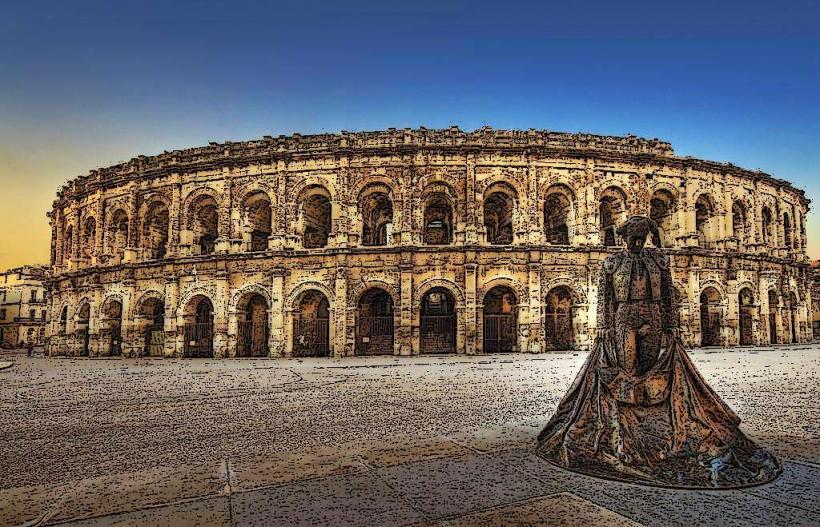Information
Landmark: Temple of DianaCity: Nimes
Country: France
Continent: Europe
The Temple of Diana in Nîmes is a mysterious and intriguing ancient structure, often considered one of the city’s most enigmatic Roman monuments. Unlike other well-preserved Roman temples in Nîmes, the Temple of Diana is not as much of a focal point for tourism but still holds great archaeological and historical significance. It is located in the Jardins de la Fontaine (Gardens of the Fountain), one of the most scenic and serene spots in Nîmes, offering a glimpse into the city’s Roman past.
Key Features and History of the Temple of Diana
1. Location and Surroundings
- The Temple of Diana is situated in the Jardins de la Fontaine, a public park located near the Fontaine de Nîmes, an ancient spring that was a crucial part of the Roman water supply system.
- The site is in a lush, green area that was once used as a religious and recreational space, complete with temples, fountains, and baths.
- The Jardins de la Fontaine is one of the oldest public gardens in France, designed in the 18th century, though it incorporates ancient Roman elements, including the Temple of Diana.
2. Architectural Style and Structure
- The Temple of Diana is a small, rectangular building made from limestone. It is built on a raised platform, with a series of columns supporting its structure.
- The temple's design is very simple and modest compared to other grand Roman temples in Nîmes, like the Maison Carrée. The building's layout is prostyle, meaning it has a columned porch at the front but no surrounding columns.
- Its interior is largely open to interpretation since it was likely built as a place for religious rituals and ceremonies dedicated to the goddess Diana, the Roman goddess of the hunt, the moon, and nature. However, the exact nature of the temple’s use remains uncertain.
- The temple is often said to be dedicated to Diana, but some scholars suggest that it might have been used for a different purpose, or perhaps dedicated to another deity entirely. There are no inscriptions that definitively confirm its dedication.
3. Uncertainty of Purpose
- One of the key aspects that make the Temple of Diana intriguing is the lack of solid evidence regarding its exact purpose and the deity to whom it was dedicated.
- The name "Temple of Diana" has been associated with the structure since the 18th century, though it is not definitively supported by any inscriptions or concrete historical evidence. Some researchers suggest that the temple might not have been dedicated to Diana at all and that the name is a later interpretation based on the proximity to the spring of Nîmes (which was a source of water and nature, qualities associated with the goddess Diana).
- The temple is located near a significant water source, and it may have been associated with water-related rituals, as Diana was often linked to nature, water, and fertility.
4. Roman Water System
- The Temple of Diana is part of the larger Roman waterworks in Nîmes, which included the Pont du Gard aqueduct and the Fontaine de Nîmes. These were key elements of the city’s ancient infrastructure, supplying water to the Roman colony of Nîmes.
- The site, including the temple, was likely part of a larger sacred precinct, where religious ceremonies were performed in connection with the natural springs and water sources.
- The Fontaine de Nîmes itself, which is located just a short distance from the temple, was one of the most important water sources in the city and may have played a role in the rituals conducted at the temple.
5. Preservation and Current State
- The Temple of Diana, like many ancient structures, has suffered from erosion and neglect over the centuries, but it is still an intriguing and atmospheric ruin that offers insight into the past.
- Today, the temple remains a partially preserved structure, with its columns and some parts of the walls still standing. It is part of the Jardins de la Fontaine, a peaceful garden with fountains, groves, and walking paths, making it a beautiful place for visitors to relax and enjoy the surroundings while contemplating the history of the area.
- The temple is often overshadowed by other more famous monuments in Nîmes, but it remains an important site for archaeology and Roman history enthusiasts.
6. Visitor Experience
- The Temple of Diana is located within the Jardins de la Fontaine, which is easily accessible from the center of Nîmes. It is a peaceful and beautiful spot, perfect for those looking to explore Nîmes’ Roman past while enjoying nature.
- The gardens surrounding the temple are open to the public and free to visit, offering a tranquil atmosphere that contrasts with the hustle and bustle of the city. Visitors can take a leisurely walk through the gardens, visit the Roman fountain nearby, and explore the temple at their own pace.
- Guided tours of the site often include the Temple of Diana as part of a broader exploration of the gardens and the Roman history of Nîmes, providing context for the temple's possible role in ancient religious practices.
7. Historical Significance
- While the exact role of the Temple of Diana in the religious and social life of Nîmes remains unclear, it is an important piece of the city’s Roman heritage. The structure is a symbol of Nîmes’ significant role as a Roman colony and its connection to the broader Roman world.
- The site also highlights the Romans’ reverence for natural elements such as water, trees, and wildlife, which were often celebrated in their religious practices.
Conclusion
The Temple of Diana is a mysterious and beautiful ruin nestled in the Jardins de la Fontaine in Nîmes. Although much of its history and purpose remain uncertain, it remains an important testament to the city’s Roman past. Its simple yet elegant design, combined with its uncertain origins, makes it an intriguing stop for those interested in Roman history, architecture, and the ancient religious practices of the time. Whether you’re exploring the gardens or reflecting on its enigmatic past, the Temple of Diana offers a unique glimpse into the layered history of Nîmes.




